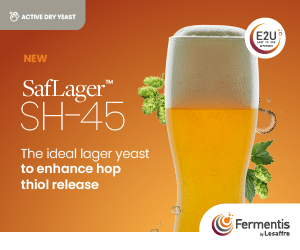Holiday Ale
OG, FG, IBUs and SRM will vary. In the BJCP (Beer Judge Certification Program) guidelines there is not a category for Holiday Ale. If you brew a holiday beer, love it and want to enter it into a homebrew competition, it should be entered in Category #24 (Specialty/Experimental/Historical). This is the category for beers that don’t otherwise meet established style categories.
We like our holiday beers to be fruity ales. They should be deep to dark brown with a long-lasting whipped-cream head. Malt aroma should fill the nose, with a background of intense fruit and maybe a hint of hops. The palate should explode with malt, with hops barely present. Full-bodied and creamy, the beer’s alcohol is subtle, and the finish should be long and mirror the palate. The alcohol content should be 6% ABV or above — both complex and warming.
Our example, Ballard’s Wassail Special Strong Ale, was first brewed as a draught beer for Christmas in 1980. It became so popular that it’s now a permanent beer in the Ballard’s portfolio. Wassail pours into your glass with hints of tawny browns and a massive, rocky head. The aroma is a complex medley of dried dark fruit, sweet malt and spicy hops. Malt enhances the palate with dark, bittersweet notes, leading to the long, dry ending. This is a beer to savor before the fireplace on dark winter evenings.
For a festive hot drink, heat Wassail and pour 12 ounces into a mug with 2 teaspoons (more or less to taste) white or brown sugar, along with a cinnamon stick. Dust some nutmeg over the top and sip.
Commercial Beers To Try
There are many special holiday beers available at this time of year. Here’s a partial list: Samuel Smith’s Holiday Ale, Scaldis Noel, Abbey Affligem Noel, Sierra Nevada Celebration Ale, Moctezuma’s Noche Buena, Traquair House Ale, King & Barnes Christmas Ale, St. Sylvester’s Flanders Winter Ale, Stille Nacht by Del Dolle Brewers, Gordon Xmas, Thomas Hardy’s and JW Lee Harvest Ale. Most breweries have a holiday or winter ale.
Hops, Malt and Yeast
Hops should be subdued and the malt should dominate. We favor spicy, earthy hops for our holiday ales. East Kent Goldings, Fuggles, Challenger, Styrian Goldings and Polish Lublin are all good choices. Bittering hops should be kept to a minimum, just enough to balance the malt sweetness. Flavor and aroma hops should also be subdued. Crystal malts are necessary with a small amount of black malt for depth of color. Honey malt is a nice grain to use, along with chocolate malt to give a nutty, complex nuance to the beer. The yeast should promote a full, malty beer; we recommend Wyeast 1968 (Special London Ale), Wyeast 1275 (Thames Valley), Wyeast 1028 (London Ale), Wyeast 1084 (Irish Ale), Wyeast 1318 (London III), White Labs WLP002 ( English Ale) or White Labs WLP004 (Irish Ale).
Serving Suggestions
Serve at 55° F in a pewter mug with a pancetta-wrapped filet mignon smothered with wild mushroom sauce and roasted garlic smashed Yukon Gold potatoes.
—
Holiday Ale
5 gallons, extract with grains; OG = 1.062; FG = 1.015; IBU = 32
Ingredients:
12 oz. British crystal malt (55° Lovibond)
1 oz. British black malt
7 lbs. Muntons extra light dry malt extract (DME)
8 AAUs Fuggles (2 oz. at 4% alpha acid) (bittering)
5 AAUs East Kent Goldings (1 oz. at 5% alpha acid) (flavor)
2 AAUs Fuggles (0.5 oz. at 4% alpha acid) (aroma)
1 tsp. Irish moss
Thames Valley (Wyeast 1275) or English Ale (White Labs WLP002)
1-1/4 cup Muntons extra light dry malt extract for priming
Step by Step:
Bring one gallon of water to 155° F, add crushed grain and hold for 30 minutes at 150° F. Strain the grain into the brewpot and sparge with one gallon of 168° F water. Add the dry malt and bittering hops.
Bring the total volume in the brewpot to 2.5 gallons. Boil for 45 minutes, then add the flavor hops and Irish moss. Boil for 13 minutes, then add the aroma hops. Boil for 2 minutes, then remove the pot from stove. Cool wort for 15 minutes in an ice bath or chill with wort chiller. Strain into the primary fermenter and add water to obtain 5-1/8 gallons.
Add the yeast when the wort has cooled to below 80° F, then oxygenate-aerate well. Ferment at 68° F for 7 days, then rack into secondary (glass carboy). Ferment until target gravity has been reached and beer has cleared (approximately 3 weeks). Prime and bottle. Carbonate at 70° to 72° F for 2 to 3 weeks. Store at cellar temperature.
Partial-mash option:
Mash 2.25 lbs. British two-row pale malt and the specialty grains in 1 gallon of water at 150° F for 90 minutes. Sparge with 2 gallons of water at 168° F. Then follow the extract recipe, omitting 1.75 lbs. of Muntons extra light dry malt extract from the boil.
All-grain option:
Mash 11 lbs. British two-row pale malt and the specialty grains in 3 gallons of water at
151° F for 90 minutes. Sparge with 5 gallons of water at 168° F. The total boil time is approximately 90 min. Add 5.9 AAU of Fuggles for the last 60 min. of the boil. Then add the flavor hops, Irish moss and aroma hops as indicated by the extract recipe.



